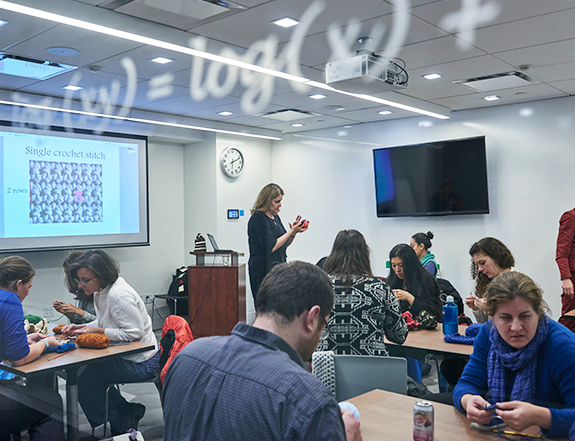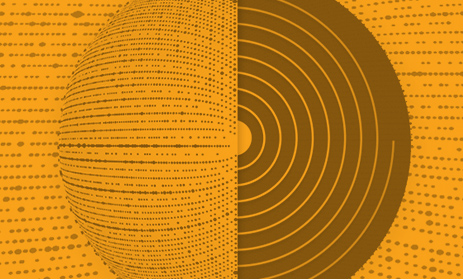
A crocheted hyperbolic plane from Cornell mathematics professor Daina Taimina's book, Crocheting Adventures With Hyperbolic Planes
For hundreds of millions of years, nature has been creating curved corals, ruffled leaves and other hyperbolic objects. In the 19th century, mathematicians figured out how to describe these objects with formulas and equations, but building accurate physical representations of them has always been a challenge. However, in 1997, Cornell University mathematician Daina Taimina, author of Crocheting Adventures With Hyperbolic Planes, figured out one way to bring hyperbolic geometry out of our imaginations and into reality: All she needed was knitting needles, crochet hooks and balls of yarn.
This year, inspired by Taimina's work, New York City high school math teacher and Math for America (MƒA) Master Teacher Dorota Caetano resolved to share this approach to generating and understanding hyperbolic objects with other outstanding teachers in the city.

Caetano is one of about 1,000 teachers in New York City who belong to MƒA, a nonprofit organization that offers fellowships to outstanding K-12 public school science and mathematics teachers. The fellowships are designed to create a professional community by convening these expert teachers for professional development events and courses, often led by other outstanding teachers in the program as well as by outside scientists, mathematicians and educators.
Approximately 10 percent of all K-12 public school mathematics and science teachers in New York City are now in this prestigious program, whose goal is to make teaching once again a respected and rewarding career choice. "Our vision is to have teachers who are true masters of their subject matter and deeply committed to the craft of teaching," says John Ewing, president of MƒA.
Caetano's workshop, "From Knit and Purl to Hyperbolic Geometry," was an introduction to the mathematical nature of knitting and explored proportionality, symmetry, pattern recognition and tessellations. Through hands-on activities, participants were able to see how they could help their students visualize difficult, complex part geometry using low-tech tools like yarn and needles. "Crochet and knitting make it possible for some of hyperbolic geometry's most mind-bending concepts to come alive in your hands," she says.
Being a part of MƒA, Caetano says, has given her new opportunities to explore her teaching philosophy. "I focus on nonroutine investigation more than before and have opportunities to dive deeply into my content area and pedagogy," she says. "More freedom. More creativity. More of what mathematics is really about."
Inspired by her involvement and learning through MƒA membership, Caetano has begun to challenge her students — and herself — with more creative, open-ended mathematical questions, understanding more than ever that mathematics is ultimately a creative endeavor. Recently, she used some of her own knitted shapes to inspire her geometry students at Vanguard High School in Manhattan to undertake an extended exploration of hexagons. "It's really cool how there are so many possibilities with shapes and yarn," says Yahya Aala, a student in Caetano's class.
"Sometimes," Caetano says, "the students don't even know where to begin. But the process of figuring things out is what mathematics is
all about."








